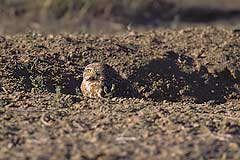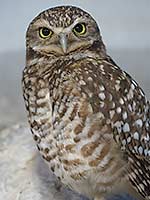As westward traveling emigrants passed through the short-grass prairies of the American West, they encountered small, curious creatures they nicknamed “Howdy Owls.” Now known as burrowing owls, these creatures would perch on the rims of their burrows or stand atop a buffalo chip and watch the procession pass by. A tilt of the head or a slight bobbing up and down was interpreted as a greeting or acknowledgement to those weary travelers passing through the owl’s neighborhood.
Some travelers probably saw humor in the way the owl’s yawned or stretched their wings while standing on one leg. The owl’s diminutive size and diurnal activity period also lent to the appreciation of these prairie dwellers.
Modern-day visitors to Canyon Country can also experience these owls minus the dust of a wagon train.
Burrowing owls are the only North American owl that uses ground burrows for nest sites. The abandoned burrows were constructed by prairie dogs, badgers, kit foxes, or other desert-dwelling mammals. The owls, like any new homeowner, redecorate the burrows to their liking by adding grass, feathers, and bits of manure around the entrance or to the nest chamber. Originally thought to mask the owl’s odor against predators, some biologists believe the manure is to attract dung beetles, one of the owl’s preferred foods.
Within the owl’s 6-10’ long nest chamber, a female burrowing egg may lay up to a dozen eggs and incubate them for a month. Her mate brings her food and stands guard near the nest keeping an eye out for rattlesnakes, badgers, coyotes, and other potential predators. When threatened, the male flies away and makes loud calls to distract the intruder and draw it away from the nest.
The male’s vigilance is rewarded with the successful hatching of young. A couple of weeks after the young hatch, they emerge from their den and hang out near the burrow entrance. The wait for food deliveries of grasshoppers, beetles, caterpillars, small lizards, mice, voles, and even scorpions by the parents.
 Good areas to look for these owls are the grasslands of the Cisco and Green River deserts, Needles Overlook, Arches National Park, and in the Montezuma Canyon drainage. Where you see pronghorn, look for burrowing owls. Listening for the bird’s harsh quail-like coo-coo call is also a great way to locate these owls. Like many birds, these owls have a repertoire of sounds that they make, including a raspy rattle that resembles the warning buzz of a rattlesnake!
Good areas to look for these owls are the grasslands of the Cisco and Green River deserts, Needles Overlook, Arches National Park, and in the Montezuma Canyon drainage. Where you see pronghorn, look for burrowing owls. Listening for the bird’s harsh quail-like coo-coo call is also a great way to locate these owls. Like many birds, these owls have a repertoire of sounds that they make, including a raspy rattle that resembles the warning buzz of a rattlesnake!
Just as the emigrants passed through the region, burrowing owls are also temporary residents. In the fall, the western populations of these owls migrate southward to Mexico or Central America. Disjunct populations that occur in Florida or the Caribbean remain there year-round.
Keep an eye, and ear, open for these small denizens of the desert during your next visit to Canyon Country. The owl’s charismatic appearance and antic behavior will reward you with a smile, just like it did for those ancestors that traveled west in search of a better life so long ago.


 Good areas to look for these owls are the grasslands of the Cisco and Green River deserts, Needles Overlook, Arches National Park, and in the Montezuma Canyon drainage. Where you see pronghorn, look for burrowing owls. Listening for the bird’s harsh quail-like coo-coo call is also a great way to locate these owls. Like many birds, these owls have a repertoire of sounds that they make, including a raspy rattle that resembles the warning buzz of a rattlesnake!
Good areas to look for these owls are the grasslands of the Cisco and Green River deserts, Needles Overlook, Arches National Park, and in the Montezuma Canyon drainage. Where you see pronghorn, look for burrowing owls. Listening for the bird’s harsh quail-like coo-coo call is also a great way to locate these owls. Like many birds, these owls have a repertoire of sounds that they make, including a raspy rattle that resembles the warning buzz of a rattlesnake!